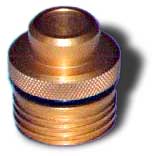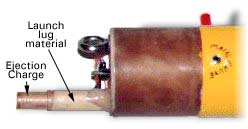Ejection Techniques & Materials
 |
Motor Ejection

|
A slow burning "delay grain" in the motor is ignited by the motor propellant when the motor ignites. (Motors are usually available with various delays, such as 4, 7 or 9 seconds). When the delay burns through the ejection charge is ignited.
Motor based ejection is simple, but failures occur when the delay's timing is not correct, and ejection occurs too early or too late. When parachute deployment is too early or too late the rocket can have enough speed that the recovery system is destroyed when the parachute inflates. Also, deploying the main parachute at apogee can result in a long walk to recover a rocket.
Electronic Control
An altimeter or timer can be used to trigger ignition of the ejection charge. Sometimes more than one method is used, with one method providing a backup to the main method.
Main parachute deployment at a low altitude is used to cause the rocket to land close to the launch location. An electronic mechanism, like an altimeter or timer, is used to activate the ejection charge. A method must be used to slow the rocket's descent before the parachute is ejected and inflates, or the recovery system can be torn apart. A typical design is to split the airframe into two pieces at apogee, and for the airframe pieces to fall horizontally to the ground. This uses air resistance to slow the rocket. A drogue (small) parachute may be need to make the airframe pieces fall horizontally.
An airframe usually consists of two pieces connected with a coupler tube. A pyrotechnic device is usually used to split the air frame at the coupler at apogee by either pressuring the airframe so that the two parts pop apart, or to propel one piece away from the other. This action also deploys the drogue parachute if one is used.
Motor ejection can be used to split the airframe, or an electronic device like altimeter, timer or radio control can be used to activate a pyrotechnic charge.
Ejection Charge Device

|
Shown here is a commercial ejection charge chamber. It is a cardboard tube with a flashbulb secured in one end. A flash bulb is shown to the right for comparison. Black powder is placed into the tube and held in place by something like masking tape tamped over the top of the powder to hold it into the tube. The powder must be lightly compressed, not loose in the tube. An electric match is powered by an electronic device like an altimeter or timer.
This example is of a single-use ejection charge tube. Tubes can be made from other materials, and some are designed to be reused. The ejection charge can be positioned to either pressurize the airframe or to propel one part of the rocket away from the other.

|
Another ignition device is an electric match like the ones used to ignite rocket motors. The type that can be used with an electronic device like an altimeter or timer must be used.
The most commonly used electric matches are made by Daveyfire.
See the Electric Matches section for more infomation.

|
This rocket uses the ejection charge to propel the upper section away from the lower section at apogee rather. The altimeter is located in the compartment to the right. The main parachute's ejection charge is located above the altimeter compartment, and is not shown.
Submitted by Dean Roth
